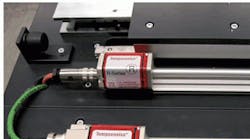Replacing linear encoders with magnetostrictive sensors
Optical or magnetic linear encoders are traditionally used to provide position feedback in applications with frequent product changes or and sophisticated machining. Linear encoders improve the positioning accuracy of electromechanical actuators in these situations by providing direct position feedback at the load to allow machines to compensate for backlash or other sources of error. Linear encoders are also used as the primary feedback device for linear motors (which directly convert electrical energy into linear motion.)
However, design engineers are increasingly replacing encoders with magnetostrictive linear position sensors to improve productivity and lower cost of ownership. The latest magnetostrictive sensors are sophisticated for installation on most electrical linear motors, electromechanical actuators, and pneumatic, hydraulic, spindle, or power-grip belt drives that perform high-accuracy, dynamic positioning.
Some designers continue to specify linear encoders for applications in which magnetostrictive sensors would work, the former is a familiar technology. However, as we'll explore, magnetostrictive sensors can replace encoders to reliably deliver dynamic closed-loop control.
Continuous feedback
One key benefit over incremental linear encoders is inherent absolute positioning. A linear encoder is basically a ruler or scale marked with increments that a reading head counts as it travels past. Each mark encodes a specific distance, so the encoder can determine how far it has moved from a reference point. There are limitations to that approach, because there are maximum and minimum speeds at which the reading head can travel before losing track of marks it scans.
Why is there a minimum speed limit? Dropping below minimum speed causes cogging because reading in between marks produces no feedback for the amplifier — so forces it to speed up until the next signal is received. The result is an uncontrolled jerky movement unacceptable in most low-speed applications. In addition, contamination or disturbances can interfere with the encoder's ability to read the marks. Magnetostrictive position sensors, on the other hand, have no maximum or minimum speed limitations because they are absolute position devices, and sample position at a fixed rate and resolution — independent of speed.
Absolute position sensors also eliminate returns to a reference mark or home position after a power reset. At any point in time, an absolute position sensor can report its location without requiring a movement. This boosts safety and productivity.
Accuracy
Older magnetostrictive sensors did not have the resolution and accuracy of better optical linear encoders. However, advancements in magnetostrictive technology over the years have now increased the overlap in performance. Magnetostrictive sensors can reach sub-micron resolutions to permit displacements at speeds of only 0.5 mm/sec; measurement cycle times down to 100 µsec, to track fast motion; linearity to ±0.01% and typical repeatability of 2.5 µm. Real-time linearity correction is available for measurement accuracy down to 20 µm or better.
Switching to magnetostrictive sensors may be appropriate in harsh environments, where an optical encoder's reading head (glass and laser) can be contaminated by dust or oil, making the marks unreadable and causing optical signal loss. The switch may also be appropriate where mechanical vibrations can damage an encoder's glass.
Page 2 of 2
Cables and networking
In optical encoders, electronics are embedded inside the reading head that moves back and forth, and it is attached to a cable — which creates design challenges. With magnetostrictive technology, the only moving part is a passive position magnet. There are no electronics or cables attached to the position magnet, only the moving machine part. This makes the magnetostrictive position sensors more rugged and reliable. In addition, the position magnet does not require physical tethering to the sensor, but can, for example, be attached to a moving carriage that comes in and out of range of the sensor. Multiple positions can even be reported from a single sensor using some interfaces such as Profibus, EtherCAT, and POWERLINK.
Linear motor pairing
Linear motors are highly dynamic and accurate, so are used for a myriad of applications. In some cases, they are also more efficient than traditional mechanical components that convert electric-motor rotary motion into linear motion — such as gearheads and belts and pulleys, for which efficiency is 90% or lower.
The strength of linear motors is that they directly convert electrical energy into mechanical translation: A magnetic field of traveling waves generates the force at the moving part. Linear motors are used in electronics, automotive, printing or robotics industries, or in the general mechanical engineering fields of machine tools, cutting machines, handling and assembly or packaging machines.
Due to the dynamics and accuracy of the moves they execute, linear motors do require suitable linear-position feedback. Despite the presence of a strong magnetic field that drives the linear motor, many have been fitted with magnetostrictive sensors without issue. These sensors are designed with double shielding to eliminate electrical interference for high signal-to-noise ratio.
For more information or technical data, call (800) 633-7609 or visit mtssensors.com.
Application crossover
Magnetostrictive sensors are best known for their use in the hydraulics world — where cylinders are exposed to the roughest environments. The sensors are useful there, because they are rugged: All sensor parts are enclosed, and the nonwearing magnets last the life of the equipment.
In contrast, in the machine-tool world, linear encoders have always been the feedback devices of choice. Why? Most electromechanical actuators and drives used to require the incremental quadrature or sinusoidal signals output by these encoders.
Today, magnetostrictive sensors are available with mounting and interface options for machine tools, including the absolute SSI interfaces common on linear encoders. So, in many applications where an encoder was previously used, magnetostrictive sensors are now another option.
